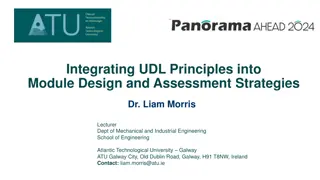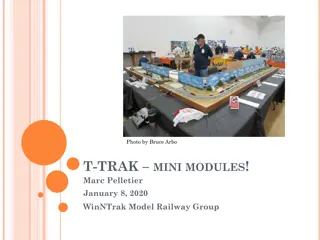Health in All Policies (HiAP) Workshop in Paramaribo, Suriname - May 2015
Join the Health in All Policies (HiAP) Workshop in Paramaribo, Suriname, to explore the role of government in promoting intersectoral collaboration for better health outcomes. Learn about key terms, barriers, conducive conditions, and practical examples related to HiAP implementation. Gain insights into government responsibilities and the importance of health equity in public health strategies.
Uploaded on Dec 14, 2024 | 0 Views
Download Presentation

Please find below an Image/Link to download the presentation.
The content on the website is provided AS IS for your information and personal use only. It may not be sold, licensed, or shared on other websites without obtaining consent from the author. Download presentation by click this link. If you encounter any issues during the download, it is possible that the publisher has removed the file from their server.
E N D
Presentation Transcript
Health in All Policies (HiAP) Workshop Paramaribo, Suriname 5-6 May 2015 Ballroom TORARICA
The Role of Government in HiAP/Whole of Government Approaches Facilitator: Dr Emily Henderson e.j.henderson@durham.ac.uk 1
Session structure Review of learning objectives Part 1: Conditions that promote or hinder intersectoral collaboration o Lecture on the role of government and the HiAP approach o Group reflections on conditions that promote or hinder intersectoral collaboration Part 2: Structures and mechanisms for intersectoral collaboration o Lecture on structures and mechanisms for intersectoral collaboration o Guest lecture from Mrs Marianne Flach, UNICEF Representative, Guyana and Suriname o Questions and feedback o Tea/coffee break o Group activity on structures and mechanisms for intersectoral collaboration Questions and feedback Comfort break 5 mins 2
Learning objectives Describe the role of government in the HiAP approach Recognize a range of terms that refer to intersectoral action Explain some of the barriers to closer intersectoral collaboration Describe conditions conducive to the HiAP approach List and appraise different structures and mechanisms for intersectoral action Discuss examples of HiAP in practice 3
The Role of Government in HiAP/Whole of Government Approaches Part 1: Conditions that promote or hinder intersectoral collaboration 4
Lecture: The role of government and the HiAP approach 5
Focus of session Focus on implementation of HiAP from perspective of government Policy formulation and implementation cycle 6
Responsibility of government Historically, the principle of government responsibility for the health of its population has been central to public health. The redistributive powers of government have also been critical for redressing health inequalities. The government s role in health is therefore a matter of principle and pragmatism. 7
Roles of government Roles of governments in the HiAP approach include but not limited to: Commissioning research; Engaging stakeholders within and beyond government; Formulating and implementing intersectoral policies; and Evaluating their impact. 8
Terminology Intersectoral action: coordinated efforts of two or more sectors within government to improve health outcomes. Intergovernmental: horizontal and vertical linkages between levels of government within a country. whole-of-society approach: coordinated efforts to improve health by multiple stakeholders withinand outside government that may also be from several sectors. 9
Group activity: Conditions that promote or hinder intersectoral collaboration Handout Alcohol control policy and practice status in Suriname Ministry of Health 10
Hinder Some notable barriers to successful intersectoral collaboration within government are likely to include: o Distracted or unstable leadership; o Conflicting personalities; o Fragmented government functions; o Sub-national geographical and government jurisdiction divisions; o Sectors appearing to have competing interests; o Limited or misused resources (staff, funding, etc.); and o Restricted policy space. 11 Title of the Presentation
Promote Intersectoral collaboration is often most effective under the following conditions: o Government supports and encourages intersectoral action; o Sectors have shared interests or both/all benefit from cooperation; o Issue has high political importance and requires urgent addressing; o Proposed policy has public support; o Strong, effective leaders in the bureaucracy (policy champions/entrepreneurs); o Intersectoral action is well planned with clear objectives, roles and responsibilities; o Laws exist or are planned to support the proposed policy; o Sufficient resources are available; and o There are plans to monitor and sustain outcomes. 12 Title of the Presentation
Group activity: Conditions that promote or hinder intersectoral collaboration In your small groups, come up with a list of conditions or situations that promote or hinder working across sectors and levels of government as relating to alcohol policy. Elect someone in each group to share the group s ideas. **Reminder of ground rules** 13
The Role of Government in HiAP/Whole of Government Approaches Part 2: Structures and mechanisms for intersectoral collaboration 14
Lecture: Structures and mechanisms for intersectoral collaboration 15
Policy scenarios that favour a HiAP approach HiAP has been implemented differently in different contexts reflecting local social and political cultures as well as government structures. Nevertheless, it is possible to make some generalizations about the structures and mechanisms commonly used for intersectoral action. 16
Overview of structures and mechanisms and HiAP 1. Cabinet committees and secretariats 2. Parliamentary committees 3. Interdepartmental committees and units 4. Mega-ministries and merges 5. Joint budgeting 6. Intersectoral policy-making procedures 7. Non-government stakeholder engagement 18
1. Cabinet committees and secretariats Cabinet committees allow ministers to engage with policy issues of cross- departmental significance offer a mechanism for ministers to work with outside interests. one of the highest decision-making bodies, they do have the potential to promote and implement a HiAP approach 19
2. Parliamentary committees can play a role in agenda setting, promoting wider political ownership of issues and reviewing policy decisions. can enhance the potential influence can support the longevity of an issue as a political priority despite a change of government. likely to have the most notable influence on the agenda setting and policy review stages of the policy cycle. 20
3. Interdepartmental committees and units two of the most common mechanisms for intersectoral collaboration. operate at the bureaucratic level and aim to re-orient ministries around a shared priority. provide a forum for problem solving and debate. can potentially influence the entire policy cycle. 21
4. Mega-ministries and merges grouping of several large government functions such as health, transport, labour, social security and education are rare. It is more common to merge smaller units or portfolios such as sport or culture with a larger ministry. The costs of large reorganizations tend to be high and the benefits are contested. 22
5. Joint budgeting can range fully integrated budgets for the provision of a service or policy objective loose agreements between sectors to align resources for common goals, while maintaining separate accountability regarding the use of funds. a promising way to promote and implement HiAP and has the potential to mainly influence the implementation stage of the policy cycle. 23
6. Intersectoral policy-making procedures includes procedures such as impact assessments and policy proposals circulating through multiple ministries for comment prior to review by the responsible minister. These procedures differ significantly between countries and can be mandatory or voluntary. Such mechanisms tend to influence the policy formation stage and represent a relatively low but regular level of intersectoral action. 24
7. Non-government stakeholder engagement Government engagement with non- government stakeholders is a crucial component of the HiAP approach While non-government stakeholders can play a role at all stages of the policy cycle, stakeholder engagement as a government mechanism is most common during the agenda setting, policy formation and policy implementation stages. 25
Guest lecture: Mrs Marianne Flach UNICEF Representative Guyana and Suriname UNDAF/Suriname within the framework of the social determinants of health using HiAP as a tool 27
The Role of Government in HiAP/Whole of Government Approaches Part 2: Structures and mechanisms for intersectoral collaboration CONTINUED 30
Group activity: structures and mechanisms for intersectoral collaboration Handout Alcohol control policy and practice status in Suriname Ministry of Health Refer to and become familiar with pages 5-7, last section Roadmap for Suriname What are its strengths and limitations? 31
Group activity: structures and mechanisms for intersectoral collaboration Open to the group: what structures and mechanisms or other formats can we use to carry forward this agenda? Any other areas that need addressing to carry forward this agenda? 32
Comfort break Please feel free to stretch or use the facilities for: 5 minutes 34























